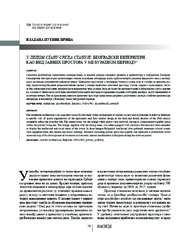U lepom stanu sreća stanuje - beogradski enterijeri kao vid javnih prostora u međuratnom periodu
'A nice apartment is where happiness resides': Belgrade interiors as form of public space in interwar period
| dc.creator | Putnik Prica, Vladana | |
| dc.date.accessioned | 2021-10-12T12:28:17Z | |
| dc.date.available | 2021-10-12T12:28:17Z | |
| dc.date.issued | 2017 | |
| dc.identifier.issn | 1450-605X | |
| dc.identifier.uri | http://reff.f.bg.ac.rs/handle/123456789/2301 | |
| dc.description.abstract | Stambena arhitektura predstavlja značajan izvor za analizu razvoja modernog društva i arhitekture u međuratnom Beogradu. Specifičan tip prostorne organizacije stanova i uređenja enterijera tokom treće i četvrte decenije dvadesetog veka u velikoj meri odslikava svakodnevni građanski život. Centralnu prostoriju u enterijeru činio je salon, koji je služio za primanje gostiju, predstavljajući javni reprezentativni odeljak u okviru privatnog životnog prostora. Salon, zajedno s trpezarijom, često je bio opremljen luksuznim nameštajem i predmetima čija je svrha bila da ukažu na intelektualni i materijalni status vlasnika. Saloni su bili mesta okupljanja intelektualne elite Beograda i održavanja brojnih kulturnih događaja, poput književnih i muzičkih večeri. Ovo istraživanje javnosti privatnog prostora predstavlja doprinos razumevanju razvoja stambene arhitekture, enterijera i nameštaja u Beogradu tokom međuratnog perioda. | sr |
| dc.description.abstract | The residential architecture is an important source for the study of the development of modern society and architecture in interwar Belgrade. A specific way of spatial organization of the apartments and their interior design in the third and fourth decades of the 20th century essentially reflect the everyday life. The central room was the lounge where guests were received, serving as a representative public space within the private living one. The lounge, together with the dining room, was often equipped with luxurious furniture and items intended to display the intellectual and social status of the owner. In these lounges Belgrade’s intellectual elite gathered; numerous cultural events were organized there, like literary and music evenings. Research on turning private space into a public one represents a contribution to the understanding of the development of residential architecture, interior and furniture in Belgrade during the interwar period. | en |
| dc.publisher | Zavod za zaštitu spomenika kulture grada Beograda, Beograd | |
| dc.relation | info:eu-repo/grantAgreement/MESTD/Basic Research (BR or ON)/177013/RS// | |
| dc.rights | openAccess | |
| dc.rights.uri | https://creativecommons.org/licenses/by/4.0/ | |
| dc.source | Nasleđe | |
| dc.subject | privatnost | sr |
| dc.subject | javnost | sr |
| dc.subject | enterijer | sr |
| dc.subject | Beograd | sr |
| dc.subject | arhitektura | sr |
| dc.subject | 1918-1941 | sr |
| dc.subject | publicity | en |
| dc.subject | privacy | en |
| dc.subject | interior | en |
| dc.subject | Belgrade | en |
| dc.subject | architecture | en |
| dc.subject | 1918-1941 | en |
| dc.title | U lepom stanu sreća stanuje - beogradski enterijeri kao vid javnih prostora u međuratnom periodu | sr |
| dc.title | 'A nice apartment is where happiness resides': Belgrade interiors as form of public space in interwar period | en |
| dc.type | article | |
| dc.rights.license | BY | |
| dc.citation.epage | 88 | |
| dc.citation.issue | 18 | |
| dc.citation.other | (18): 79-88 | |
| dc.citation.rank | M52 | |
| dc.citation.spage | 79 | |
| dc.identifier.doi | 10.5937/nasledje1718079P | |
| dc.identifier.fulltext | http://reff.f.bg.ac.rs/bitstream/id/1066/2298.pdf | |
| dc.type.version | publishedVersion |

